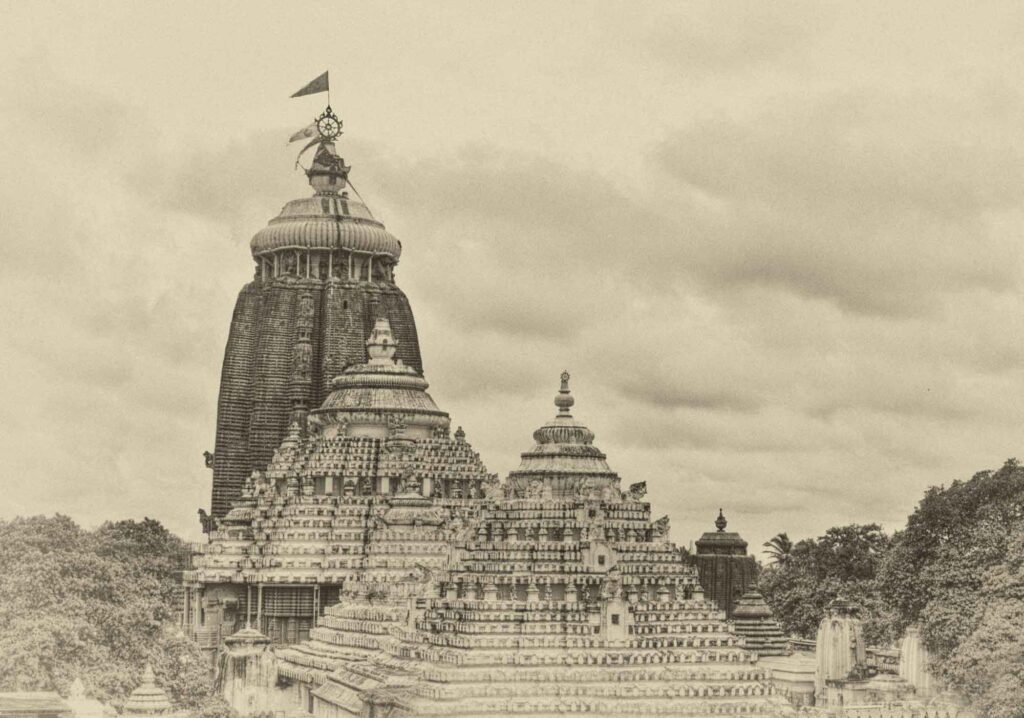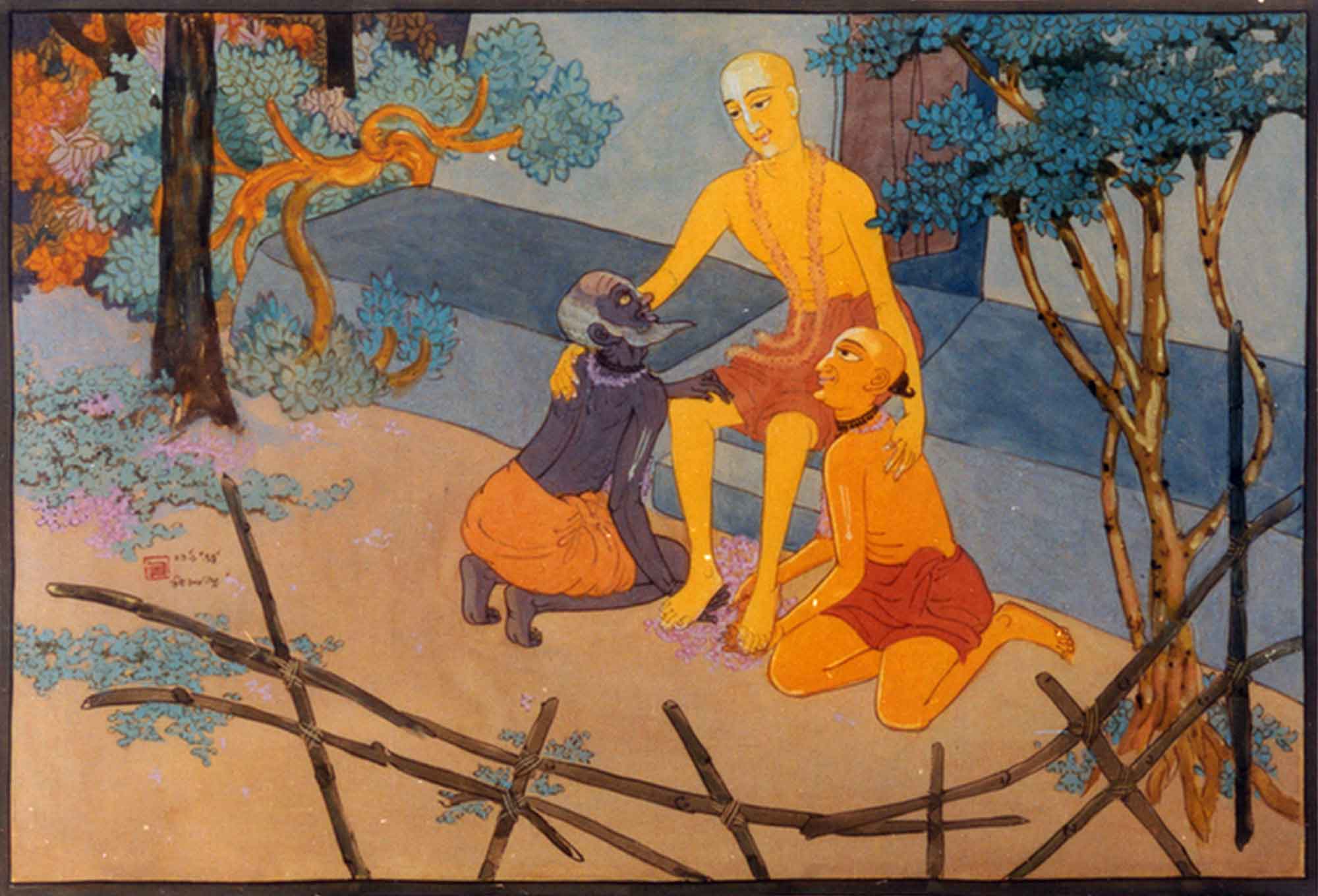Overview
Ādhyātmika u Aprākṛta (Impersonal Spirituality and Transcendental Spirituality) was originally published as ‘samālocanā (A Book Review) in Sajjana Toṣaṇī, Vol. 8 issue 7 in 1896. Herein, Bhaktivinoda Ṭhākura reviews a small book that tries to give rational explanations for Kṛṣṇa’s aprākṛta-līlā.
(translated by Swami B.V. Giri)
Śrī Śrī Bhagavān Śrī Kṛṣṇa’s līlā etc. is established in aprākṛta-tattva (transcendence). A small book has been composed by Śrīyukta Kanāi-lāla Candra Mahāśāya attempting to establish the aprākṛta-tattva of Kṛṣna’s character, by giving ādhyātmika (spiritual) meanings to the narrations of the vastra-haraṇa and rāsa-līlā. Nowadays many persons with scholarly pride do not understand the essence of kṛṣṇa-līlā and make many offences. It is commendable that Kanāi Bābu has taken care to eradicate their erroneous views here. This is how Kanāi Bābu has expressed the meaning of the rāsa-līlā:
“The ādhyātmika significance of the rāsa–līlā is that Bhagavān Śrī Kṛṣṇa is our Paramātmā, and His potency, or prakṛti is our jīvātmā. These two exist within us. The Paramātmā does not share the jīva’s happiness or sorrow, but the ātmā shares the happiness and sorrow of the jīva. Although the jīvātmā is the potency of the Paramātmā, nevertheless, in order to experience happiness and distress, she must be without a svāmī (husband) and deprived of supreme bliss. She considers the jīva’s husband to be her husband, the jīva’s son to be her son, she becomes happy when the jīva is happy, and sad when the jīva is sad. Bhagavān has left His own potency behind, immersed in a sea of sorrow. If this is so, why did He do such a thing? The answer is that if He had not done so, the material world would not have been created.
mahā-māyā prasādena saṁsāra-sthiti kāriṇaḥ
tan natra vismayaḥ kāryo yoga-nidrā jagat-pateḥ
(“By the mercy of Mahāmāyā, the world is maintained. This is nothing amazing, as she is the yoga-nidrā potency of the Lord of the universe.” – Devī Māhātmya 1.54)
However, if the jīva, by Bhagavān’s mercy, severs the bond of māyā, and through firm bhakti rejects external relationships, then following her true husband, the Paramātmā, she can eternally enjoy supreme bliss. In order to be perceptible to mundane eyes, Bhagavān Kṛṣṇa appears on this earth.”
We cannot comprehend Kanāi Bābu’s point. We cannot understand who was the specified additional jīva besides the jīvātmā and the Paramātmā. Moreover, what is this idea that happiness and distress are the līlā of the jīvātmā and the Paramātmā? If it is said that the Paramātmā and the jīvātmā resides in our heart, then I become a separate entity from that of the jīvātmā. We cannot agree with such completely contradictory conclusions.
In trying to reveal the ādhyātmika explanation of rāsa-līlā, transcendental kṛṣṇa-līlā has become shrouded in a web of rationalism, It seems that kṛṣṇa-līlā never happened. It was simply metaphorical imagination. Kṛṣṇa-līlā, which is the transcendental Absolute Reality, and merging into Brahman are inherently not one. Everything that is described about aprākṛta-līlā is eternally true. It is never simply metaphorical imagination. The difference between mundane history and aprākṛta-līlā is that mundane history is completely material and subject to time, so it is temporary. Although aprākṛta-līlā seems to resemble mundane activities, there is no mundanity in it. It is all transcendental. It is said that by Kṛṣna’s mercy, it can be perceived even with physical eyes, although no part of it is a phenomenon of this world comprising of the five gross elements. Kṛṣṇa-līlā transcends matter, and in fact, it is indriyātīta (it transcends the senses). By saying indriyātīta, we should understand that it is beyond the material senses. It is perceivable by the transcendental senses of a transcendental jīva. Thus, by the mercy of Śrī Kṛṣṇa, when He appears in this material world, then by His grace, the jīva can perceive that līlā with his transcendental senses. Therefore, no part of kṛṣṇa-līlā is metaphorical or mundane.
Furthermore, kṛṣṇa–līlā is not ādhyātmika. The verb ādhyātmika only arises when all tattvas terminate in one Brahmātmā. Only māyāvāda is an ādhyātmika phenomenon. When the significance and mood of ādhyātmika prevails, then kṛṣṇa-līlā and the transcendental vṛndāvana-līlā are extinguished. Kṛṣṇa-līlā is diverse. The concept of ādhyātmika and the concept of diversity are opposed to each other. In the ādhyātmika concept, the Absolute Truth is one, and that is the indivisible Brahman that possesses latent energy. The eternally existing kṛṣṇa-līlā only arises due to the activities of His diverse potencies. These two concepts are mutually contradictory, yet in connection with the Absolute Truth, they do not contradict each other.
Thus, on the path of jñāna when ekam evādvitīyaṁ brahma (‘Brahman is one without a second’) arises within the concept of ādhyātmika, then at that time, the Absolute Truth who is endowed with diverse energies, manifests kṛṣṇa-līlā within the eternal dhāma of Vṛndāvana. The ādhyātmika and aprākṛta conceptions do not fit simultaneously into human calculation. Yet whoever has the mercy of the Absolute Truth can find harmony within these two opposite principles. Through the acintya–śakti, both can be realised as bhedābheda (one and different).
Rationalists, whether they identify themselves as Brahmos or Vaiṣṇavas, can never conceive of this acintya-bhedābheda-tattva in their hearts. Thus they tumble down into the ādhyātmika concept. Kanāi Bābu is known to be a Vaiṣṇava and a servant of Śrīman Mahāprabhu. Therefore, he should understand acintya-bhedābheda-tattva as taught by Śrīman Mahāprabhu and not corrupt the pure Vaiṣṇava philosophy by giving adhyātmika meanings to the līlā of Śrī Kṛṣṇa. He should learn that kṛṣṇa-līlā is completely aprākṛta.













